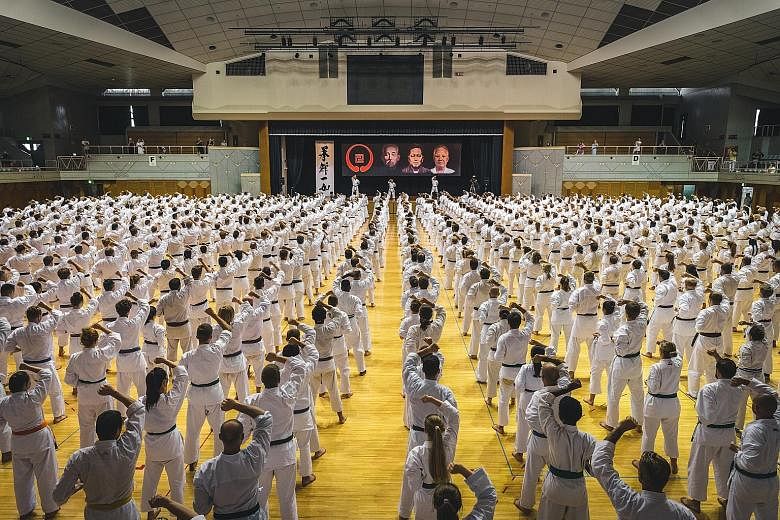Radhika Pandya has visited Okinawa annually since 2015 but not for holidays.
The Singapore permanent resident, a freelancer in conflict facilitation, travels to the Japanese prefecture to hone her karate skills, spending a week or two there each time.
"The first trip in 2004 was like a pilgrimage to a holy place - I must have been in awe of everything I experienced there," said the 59-year-old, who took up the sport that same year and is now an instructor at the Singapore branch of the International Okinawan Goju-ryu Karate-do Federation.
Each trip costs an average of $1,500 per week and she controls costs by aiming for the lowest prices for flights and accommodation, as well as limiting her daily spending to less than $100 a day.
She is not the only karate enthusiast who has been making a beeline for Okinawa, widely regarded as the birthplace of karate, in recent years.
When Englishman Kieran Budd, 33, first went there in 2016 to visit karate schools, or dojos, he was so impressed by the quality of training that he has been there five more times between 2017 and 2018 to train, accumulating his annual leave so that he could remain there for longer periods.
In January, the policeman took the plunge, moving from the English town of Reading to Okinawa's capital city, Naha, to train with his sensei (Japanese for teacher) Tetsuhiro Hokama. He expects to be there for at least 15 months.
"I wanted to go to the origin and see how different it is from what we get in the West. The level of detail in training and knowledge here is incredible," said Budd, who has been practising goju-ryu karate since he was six and now holds a third-grade black belt. He is now also an instructor at the Hurst Goju Ryu Karate Club in Reading.
Goju-ryu is a form of traditional karate that originated in Okinawa in the 1930s. The martial art was developed there in the 19th century and was mainly used for self-defence. Students can attain eight coloured belts, and after earning the final black belt, they can go up to a 10th-grade black belt.
Okinawa now houses almost 400 karate schools and organisations.
They conduct classes and karate events both overseas and locally, such as the quadrennial Okinawa Traditional Karate Ceremony. The July 29-Aug 4 event saw more than 1,200 participants from all over the world.
Budd and Pandya are among some 5,000 people who have travelled to the southern Japanese prefecture every year in the last five years to pay homage to the martial art, according to the Okinawa Karate Information Centre.
BACK TO BASICS
While karate has been gaining popularity due to its inclusion in the Olympics for the first time in Tokyo next year, experts also attribute the trend to people wanting to expand their knowledge of the martial art.
In most competitions, such as the Olympics and other major multi-sport games, participants use sport karate techniques, which have been adapted from traditional karate for safety reasons.
Honorary chairman of the International Meibukan Goju-ryu Karate-do Association Meitatsu Yagi, 75, said: "Nowadays, people want to come back to the roots of karate, even sports karate practitioners. When they're young, they compete. But after a certain age, they stop and become coaches.
"Then they realise that their knowledge is limited because sport karate has been adapted to be safer for competitions. They don't know much about the meaning of karate movements and history."
Chief world instructor of the International Okinawan Goju-ryu Karate-do Federation Tetsuji Nakamura, 54, added that the trend could lead to an overall rise in quality for karate worldwide, noting: "Seeing other people training hard and with the senseis watching them, it makes them want to train hard, and that brings the quality of training up. After that, they bring that intensity and momentum home with them."
PRESERVING THE CULTURE
The Okinawa Prefectural Government is working to include Okinawa's karate heritage in Unesco's Intangible Cultural Heritage list. A karate museum was opened in 2017, along with organisations dedicated to the preservation and development of that culture, such as the information centre.
The information centre plays a crucial role in promoting the martial art to enthusiasts. It keeps track of foreigners coming to Okinawa to train, provides information on karate schools and links visitors up with a suitable one.
French public relations officer at the centre Miguel Da Luz, 48, said: "Last time, there was no information about the dojos and programmes available here.
"But people who have no connection to Okinawa need support and information on where they can go and train."
Pandya, for one, wants to keep going back.
"Each subsequent trip builds my identity as a karate practitioner," she explained. "It is a place where I can transition from being a teacher to a student, because being able to focus on my own development does not happen every day."
• Laura Chia and Amanda Chang are final-year students of the Wee Kim Wee School of Communication and Information at Singapore's Nanyang Technological University. They were participating in the School's journalism programme, Going Overseas for Advanced Reporting.


